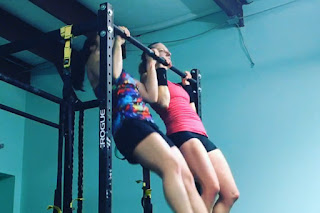As I listened to and read about the violence and subtle calls to violence by Trump and his supporters, I felt a sense of pain and embarrassment for the United States. (Okay. Maybe not so subtle calls.) Hearing the threats of one candidate against another, I had to find a touchstone of kindness in my life. There are many, many examples of people being kind to me but these two examples have stayed with me.
I meant to share this story when I did my review of the KB Instructor Certification. Unfortunately I was never able to put words to paper but this story was an important part of my success.
Last August I took the Strong First Kettlebell Instructor Certification at Achieve Fitness in Somerville. I can't remember ever feeling so nervous. Not only would I be testing myself physical, but I was facing a major mental challenge. The mental challenge was not just pushing through physical exhaustion but spending 3 days for 9 hours/day socially interacting with coaches and other participants. As an introvert, it was daunting. I was looking for any way out. It was a Friday morning. Parking in Somerville...ha ha ha. Not the easiest thing to find. I could not find a space. No space? I wasn't meant to do this...and then what happens a space opens in front of the Greek Club a stone's throw from Achieve Fitness. Point is, I was a wreck heading into the gym but said to no one in particular, "Guess I gotta to do this..."
After an exhausting morning, I headed out for lunch which was in my car. An older man was sitting on the bench outside the Greek Club drinking his coffee. He asked if I liked strong Greek coffee and asked me to join him which shockingly I did. He asked the gentleman inside to get me one of those strong Greek iced coffees and a bottle of water. We talked for an hour about who I was and what I was doing. We talked about where he was from and life in Greece.
When I got my lunch I was feeling like I need to be alone. However, this man's kindness and conversation was what I need. It rejuvenated me. I was ready to take on the afternoon!
The second act of kindness...anyone who reads this blog or my facebook page knows I love the Newburyport Farmer's Market. Usually I go messy and sweaty after working out. This one particular day, I decided I needed eggs and not just any eggs. I needed eggs from 17 State Street Cafe in downtown Newburyport.
I was seated at a rather large table for one person. I ordered and was drinking my coffee...just chilling for a bit...lost in my thoughts.
The waitress came over and asked if I would move to a smaller table which I did...no problem. It was a large table and apparently there was a very large party waiting to be seated. The waitress thanked me a number of times for being so accommodating.
I finished and asked for the check. The waitress said, "No, you were very nice about moving to another table. You do not have to pay for your breakfast. I am picking up the check."
I was very moved at the time, and still am, by how nice she was to do that.
How great would life be if we could all be just a little nicer, a little kinder to each other? She felt good because I moved without complaint. Why should changing tables be a problem for me? She paid for my meal. We both felt good that Sunday because of a little bit of kindness and consideration.











































